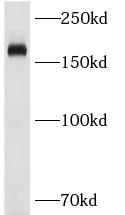Products
CD206 antibody
Category:
Research Area:
| Synonyms: | CD206 antibody, CLEC13D antibody, Macrophage mannose receptor 1 antibody, Mannose receptor antibody, mannose receptor antibody, C type 1 antibody, MMR antibody, MRC1 antibody | ||
| Catalogue No.: | FNab09912 | Reactivity: | Human, Mouse, Rat |
| Host: | Rabbit | Tested Application: | ELISA, WB, IHC, IF |
| Clonality: | polyclonal | Isotype: | IgG |
- SPECIFICATIONS
- Product Name
- CD206 antibody
- Catalogue No.
- FNab09912
- Size
- 100μg
- Form
- liquid
- Purification
- Immunogen affinity purified
- Purity
- ≥95% as determined by SDS-PAGE
- Clonality
- polyclonal
- Isotype
- IgG
- Storage
- PBS with 0.02% sodium azide and 50% glycerol pH 7.3, -20℃ for 12 months(Avoid repeated freeze / thaw cycles.)
Immunogen
- Immunogen
- mannose receptor, C type 1
- Alternative Names
- CD206 antibody, CLEC13D antibody, Macrophage mannose receptor 1 antibody, Mannose receptor antibody, mannose receptor antibody, C type 1 antibody, MMR antibody, MRC1 antibody
- UniProt ID
- P22897
- Observed MW
- 166 kDa
Application
- Tested Applications
- ELISA, WB, IHC, IF
- Recommended dilution
- WB: 1:200-1:2000; IHC: 1:50-1:200; IF: 1:50-1:200
Validated Images
 Mouse liver were subjected to SDS PAGE followed by western blot with FNab09912(CD206 antibody) at dilution of 1:1000
Mouse liver were subjected to SDS PAGE followed by western blot with FNab09912(CD206 antibody) at dilution of 1:1000
 Immunohistochemistry of paraffin-embedded human lung using FNab09912(CD206 antibody) at dilution of 1:100
Immunohistochemistry of paraffin-embedded human lung using FNab09912(CD206 antibody) at dilution of 1:100
- Background
- CD206, also named as MMR, CLEC13D and MRC1, is a type I membrane receptor that mediates the endocytosis of glycoproteins by macrophages. CD206 has been shown to bind high-mannose structures on the surface of potentially pathogenic viruses, bacteria, and fungi so that they can be neutralized by phagocytic engulfment. CD206 is a 170 kDa transmembrane protein which contains 5 domains: an amino-terminal cysteine-rich region, a fibronectin type II repeat, a series of eight tandem lectin-like carbohydrate recognition domains(responsible for the recognition of mannose and fucose), a transmembrane domain, and an intracellular carboxy-terminal tail. It is expressed on most tissue macrophages, in vitro derived dendritic cells, lymphatic and sinusoidal endothelia.



